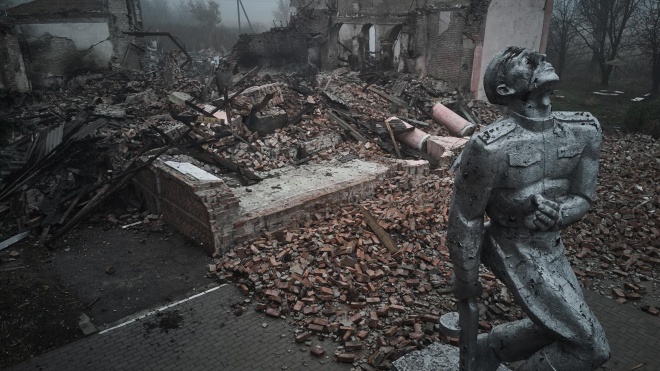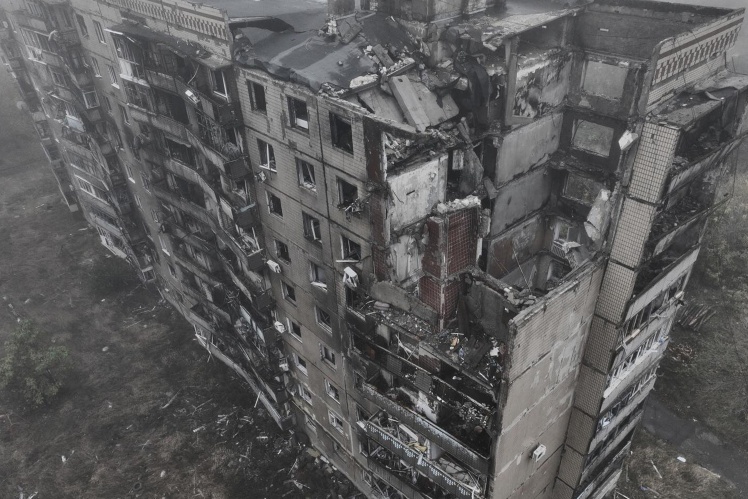Since the beginning of the full-scale invasion, the Russians have been advancing in this direction bit by bit. Why did they get more active now?
Barabash: They have already set a date many times before which Avdiivka should be taken. And they failed all times. However, there has never been such a massive offensive with such a large number of equipment and people, as now, in this direction. There are strategically important heights near Avdiivka. If they take them, a serious part of the front will feel this. They probably have a desire to "surround some Ukrainian troops", besides, they need to bring some "victory" to [Putinʼs] plate. But the fact that they went to the front in columns is a kind of problem in communications between the lower, middle and upper echelons [of the Russian military]. Because they thought it would be an easy walk. In addition, someone spread information that our main strike would be on Donetsk, so the Russians decided to do something in advance. Avdiivka is now hindering them and does not allow them to advance further, because they want to take control of the entire Donetsk region.
What started the Russian offensive?
Firsov: It all started on October 10, when they launched about 50 airstrikes on Avdiivka: guided aerial bombs, non-fragmentation bombs, everything they have in their arsenal. Before that, there were three or seven shellings a day, and here are dozens. Then they started pouring in artillery. In Avdiivka, the perimeter of the front is more than 30 kilometers — and they shelled this semicircle. And then they tried to engage infantry. And we understood the tactical plan: to take the heights in order to install anti-tank means there and shoot through all the logistics — roads to make it difficult for us to move, to deliver ammunition, and so on.
Situation around Avdiivka. The Russia-occupied territory is in dark green.
«Babel'»
Barabash: But I canʼt say that they have seriously advanced. Conditionally, the situation is the same as a year ago, there is nothing substantially new.
Did they hit military positions or the city in general?
Firsov: It is difficult to say where they aimed. They simply covered the city, shelling all over Avdiivka: hitting residential buildings or area next to them. In Avdiivka, almost all high-rise buildings are panel ones, from the shelling they simply fold up like houses of cards, even nine-story ones.
The Russians declared that they had captured the spoil tip north of the city and planted their flag there. Is this significant?
Barabash: That tip is an overestimated story. The Russians are constantly launching drones to monitor the road. That hill has no strategic importance for them, because it is impossible to gain a foothold on it. As soon as they start to climb there, ours hit them with artillery. And those flags were complete propaganda. They did not put them at the top, because they did not reach it. Therefore, even the perspective was chosen so that this was not visible. Our guys then hit those flags with FPV drones. In fact, there is a "gray zone", their and our saboteur groups, constant contact battles. That is, the struggle is not for the tip itself, but for the territory and control over it.
Firsov: Sometimes it happens that ours could withdraw or leave some position. Most often, such positions turn into a "gray zone" and are of no use, because after attacks and shelling, there remains a mess of earth, stones and trees. That is, they nominally control that territory, and we also can recapture it, but strategically it will not give us anything, because it is practically impossible to gain a foothold there.
Which Russian units are fighting near Avdiivka?
Barabash: They started transferring forces here from the Luhansk direction. From October 10, three brigades went in for the assault: two brigades of paratroopers who were to go in and take positions, and then a mechanized brigade was to be entrenched. But those two assault brigades are already broken, that is, they are not combat-ready. This does not mean that everyone there is killed, but it is sufficiently damaged. Now the Russians are pulling up various units for reinforcements, throwing reserves there. I am often asked if there are "Wagnerians" there, but I donʼt know.
Situation in Avdiivka as of November 1, 2021. Black dot is the spoil pit, white one is Avdiivka Coke and Chemical Plant.
«Babel'»
What are the fights for now?
Barabash: Russians are trying to surround the city from the north and the south. From the south, there are no dominant heights, there is a plain, so it is difficult for the Russians, they try to cling to anything.
In the north, they are trying to go in the direction of Ocheretyne, Stepove, and Berdychi, cross the railway to close the circle. They are pushing with all their strength. But, in my opinion, it is unlikely that they will succeed.
Firsov: Russians use planes, helicopters, TOSes. They are pressing from the north, near the railway from the tip side. They are trying to gain a foothold on the spoil tip, and in the lowlands under it they hide their equipment and infantry. And then there is the [coke and chemical] plant — our armed forces have good fortified positions there. Not sure the Russians will try to take it now. They probably want to bypass it and close the circle. To the south, near Vodyane, since the last days of October, they have also intensified and are trying to push forward.
Everything happens in waves: we repulsed one attack, they retreated to regroup, then again throw up their infantry, equipment, reserves and go on an assault. Since October 10, we have burned at least 80 pieces of the Russian equipment. Infantry in groups of 10-15 Russians, sometimes of 40 can storm. It is difficult and the situation is serious. This direction is important for them, but the Russians lack coherence. Itʼs good that the commander-in-chief was here, plus we received [the equipment and weapons] we needed.
The Russians are allegedly digging tunnels to get closer to the positions of Ukrainian fighters. Do you know anything about it?
Barabash: They are digging something, yes. But the Russians have already made such tunnels in the Zaporizhzhia region, and even in the Kherson region. This is so stupid. The boys see when they are digging and shell them with artillery. Thatʼs the end of the story. In addition, in the Donbas, the soils are very heavy — thatʼs alumina — you canʼt dig through them with a pickaxe, whatʼs to say about doing this underground. I wouldnʼt take it seriously at all. The military also think so.
Firsov: Their task is to take Avdiivka at any cost, so itʼs easier to name what they didnʼt try here. People say that once they even crawled through some pipe, but I donʼt know if this is true. Therefore, it is quite possible that they could try to dig tunnels.
How is it now with logistics there, is it possible to deliver everything necessary to the [Ukrainian defenders of the] city?
Barabash: The road from Ocheretyne to Avdiivka is 22 kilometers long. Since the beginning of the full-scale invasion, the Russians targeted. Several of their drones are constantly hovering in the sky. If they see any movement, they simply hit with "Hrads" if they can reach. If not, they hit with barrel artillery, of 152-mm caliber, or with anything they can get their hands on. They donʼt care who is driving that road and what cargo they are carrying. They strike not only when someone moves into the city, but also when someone leaves, they even try to intercept the evacuation of civilians or volunteers. Russians donʼt care.
Consequences of Russian attacks on Avdiivka. A house destroyed by Russian troops in Avdiivka.
Konstantin and Vlada Liberov / «Babel»
What is the humanitarian situation in Avdiivka now?
Barabash: There was no water a couple of months before the beginning of the large-scale war, since the Russians cut off the electricity at the Donetsk filter station and did not let us repair it. There has been no electricity since April 2022, and gas since May of the same year. There is not a single intact building in this city. People live in basements and survive on humanitarian aid. But the other day, we moved in the necessary things for several months, bread.
The authorities have repeatedly announced forced evacuation, but people still remain in the city. Is it clear how many there are and whether there are children among them?
Barabash: The forced evacuation involved children, and currently there are no kids in the city. At the end of October, Mrs. [Iryna] Vereshchuk said that a Cabinet [of Ministers] resolution on the forced evacuation of the adult population is under preparation — a mechanism still should be formulated. As of Wednesday, there were 1,599 people in Avdiivka. We know who they are and where they live, because they all receive humanitarian aid. Before the full-scale invasion, there were officially 33 thousand people in the city, but in fact about 26 thousand. People are leaving even now.
Translated from Ukrainian by Anton Semyzhenko.
In order for the Armed Forces of Ukraine to protect Avdiivka, support the "Return Alive" Foundation.



